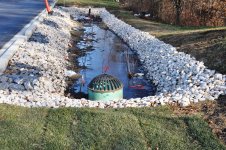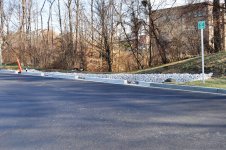Clean Water Act
[FONT=Arial,Arial][FONT=Arial,Arial]In 1972, Congress enacted the first comprehensive national clean water legislation in response to growing concern of serious and widespread water pollution. The Clean Water Act states "no person shall throw, drain, or otherwise discharge, cause, or allow others under its control to throw, drain, or otherwise discharge into the municipal separate storm sewer system (a.k.a. MS4) any pollutants or waters containing any pollutants, other than storm water". [/FONT][/FONT]
[FONT=Arial,Arial][FONT=Arial,Arial]
The Clean Water Act administration raised the penalty for class 1 penalties to over $30,000 and class 2 penalties to over $150,000. Violations to the CWA can cost up to $11,000 a day for each day of illegal operation.
If your discharge does not reach the waters of the United States, then there are no requirements under the Clean Water Act.
[/FONT][/FONT]Cosmetic Cleaning only (First of all "Cosmetic" cleaning denotes cleaning that is not necessary. "Health and Safety" cleaning or something like that denotes a necessary service.)
[FONT=Arial,Arial][FONT=Arial,Arial]This BMP is for regular maintenance CosmeticHealth and Safety Cleaning and is not for the purpose of cleaning hazardous materials or hazardous waste. [/FONT][/FONT]
[FONT=Arial,Arial][FONT=Arial,Arial]
[/FONT][/FONT]Always Pre-clean
[FONT=Arial,Arial][FONT=Arial,Arial]Before power washing begins collect debris such as dirt, sand, leaves, twigs, etc. by sweeping with a broom, using a leaf blower, or vacuum and dispose of in a trash receptacle or dumpster. [/FONT][/FONT]
[FONT=Arial,Arial][FONT=Arial,Arial]
Never discharge dirt, sand, leaves, twigs or any other solid into the Sanitary Sewer or Storm Drain.
Before power washing begins clean oil and grease spots with an oil absorbent clay (such as kitty litter) (or any other effective method) and dispose of in a trash receptacle or dumpster.
[/FONT][/FONT]Always Filter Wash Water before Discharging
[FONT=Arial,Arial][FONT=Arial,Arial]Remove silt, sand, sludge, debris, etc. by filtering through a (purpose designed filter media or a) 20 mesh screen or smaller. [/FONT][/FONT]
[FONT=Arial,Arial][FONT=Arial,Arial]
4
[/FONT][/FONT]
[FONT=Arial,Arial][FONT=Arial,Arial]- A 20 mesh screen is similar in size to traditional panty hose/nylon stockings. [/FONT][/FONT]
[FONT=Arial,Arial][FONT=Arial,Arial]
Remove hydrocarbons by filtering through an oil absorbent filter/oil sock or oil/water separator such as an oil absorbent boom, recycling system, sand trap, grease trap, clarifier, etc).
- Hydrocarbons are oil and grease pollutants. (Strike this whole sentence, we are not working for the EPA so we don't need to educate them on what pollutants are unless they start calling non-pollutants pollutants like they recently did with an over abundance of storm water and got shot down in federal court.)
- After the wash water is filtered, there should not be any oil sheen (multi colored water).
[/FONT][/FONT]Wash Water Capture
[FONT=Arial,Arial][FONT=Arial,Arial]1st Choice - Use a permanent pad to capture the wash water. [/FONT][/FONT]
[FONT=Arial,Arial][FONT=Arial,Arial]
- A permanent pad is typically made of concrete and is designed for washing vehicles while preventing wash water from reaching a Storm Drain.
2nd Choice - Use a portable pad to capture the wash water.
3rd Choice - Seal the Storm Drains and capture the wash water with a vacuum system, sump or other technology. (All of this needs to go, in this context, unless we make another heading for fleetwashing/car washing, you are confusing people with this)
- The type and technology of the system is the responsibility of the contract cleaner.
4th Choice - Evaporation is acceptable as long as the evaporation occurs on property and on a surface that will not absorb contaminants. After the surface has dried the contaminants need to be swept or vacuumed up so that when it rains the contamination will not be washed away. If the surface is a gravel or porous surface, the water table must be at such a depth where the groundwater will not be polluted. Check with your local municipality. (More fleetwashing lingo)
[/FONT][/FONT]Discharge to the Sanitary Sewer - Preferred (This word "preferred" needs to go entirely. I know that some BMP's have such verbiage, but this just puts it in a regulators head that since one way is "preferred" why give them any other options. Especially since it is coming from one of our OWN orgs! )
[FONT=Arial,Arial][FONT=Arial,Arial]Discharging to the Sanitary Sewer is allowed with a Cosmetic Cleaning permit. [/FONT][/FONT] (Needs to to, confusing, right below this you say some cities require it and some do not)
[FONT=Arial,Arial][FONT=Arial,Arial]
- Some cities require a permit others do not. Contact your Public Works department for your city's requirements. The Public Works department may need to direct you to another department.
Discharge must be in compliance with local regulations and limits (Solids less than 250 mg/L, Petroleums less than 250 mg/L) (Needs to go confusing and doesn't mean a thing at the local level), and may require pre-treatment, sampling, and possibly other measures.
- This will depend on the municipality.
- The city of Fort Worth has never been able to detect wash water from Cosmetic Cleaning in their POTW (Publicly Owned Treatment Works).
Ensure pH of the wash water is between 5.0 and 12.0 (use pH test strips) and below 150˚.
- These limits are typically above normal Cosmetic Cleaning wash water.
Filter using the best available method that removes the largest amount of contaminants.
- Sand Trap, Grit Trap, Grease Trap or Clarifier.
- If these options are not available then discharge to a mop sink, utility sink, kitchen sink, toilet, inside floor drain, or Sanitary Sewer clean-out stub.
- Never remove the Sanitary Sewer or Storm Drain manhole cover as these are City Property and require authorization to open. 5
[/FONT][/FONT]
Discharge to Landscape Areas - 2nd Choice
[FONT=Trebuchet MS,Trebuchet MS][FONT=Trebuchet MS,Trebuchet MS]For discharges to landscape areas you must do the following: [/FONT][/FONT]
[FONT=Trebuchet MS,Trebuchet MS][FONT=Trebuchet MS,Trebuchet MS]
[/FONT][/FONT][FONT=Arial,Arial][FONT=Arial,Arial]- Obtain the property owner’s permission.
- Ensure discharge volume is small enough that it soaks into the ground without running off property. Limit your discharge to 1,000 gallons/acre per month. (should add, "in any one area")
On property wash water discharge can only occur at the property where the wash water is generated.
Do not discharge repeatedly to the same landscape area because doing so may contaminate soil and groundwater, damage plants and cause other nuisance conditions.
Off property discharge can cause serious harm to groundwater. (once again here we are doing the EPA's job for them. This sentence needs to go)
-Contract cleaners that are near a body of water like San Francisco, Miami, Fort Lauderdale can contaminate ground water. Example, if building a fence in your area were to hit ground water, the water table is high and discharging would pollute the groundwater. It is important to check with your local municipality. As a general rule, the water table needs to be 50 feet down depending on your type of soil. (This is not a big issue with the EPA at the moment plus it opens the door for guys like Jeff LeCours to be put out of business or forced to by tens of thousands more in equipment to do a job that is already environmentally friendly. Do you dislike Jeff Lecours that much?)
Ensure pH of the wash water is between 6.0 and 9.0 by using pH test strips.
[/FONT][/FONT]Recycled Wash Water - 3rd Choice
[FONT=Arial,Arial][FONT=Arial,Arial]If the wash equipment being used recycles the water for reuse, the following may apply. [/FONT][/FONT]
[FONT=Arial,Arial][FONT=Arial,Arial]
- All discharge locations are to be reported to the Sanitary Sewer Department in advance of discharging wash water.
- Recycled wash water typically must be tested annually and the results reported to the Sanitary Sewer Department as required.
Recycling wash water has the effect of concentrating the contaminants and pollutants. The POTW (Publicly Owned Treatment Works) do not typically accept concentrated waste water. If the waste water is recycled long enough the pollution becomes hazardous waste. There is a continuous buildup of total dissolved solids, heavy metals, and detergents. This then requires the contractor to have a hazardous waste haulers permit. (Add this option it not usually practicable and is detrimental to the market and will result in costs that deter frequent health and safety cleaning, thus is not recommended except in cases where contamination of waters of the US is imminent and there are no other feasible options.)
[/FONT][/FONT]Discharge to Storm Drains - not recommended (Get rid of this garbage,)
[FONT=Arial,Arial][FONT=Arial,Arial]Never discharge detergents, chemicals, or hot water to Storm Drains. [/FONT][/FONT] (Add, hot water that will reach ambient temperature prior to reaching any receiving waters is acceptable)
[FONT=Arial,Arial][FONT=Arial,Arial]
Washing with cold water (less than 110°F) and no chemicals is considered no worse than a rain event and may be discharged to Storm Drains for surfaces that do not have oil and grease or other contaminants. (Get rid of this entirely)
Water that is greater than 110°F is considered hot water and considered the same as using soap. (Take this verbiage, burn it, curse it, stomp on it, and hope no one ever repeats it.)
- Hot water is an emulsifier and similar to using a detergent. (Ditto!)
Discharges must be free of foam and oil sheen.
- An oil sock will remove foam and oil sheen.
[/FONT][/FONT]






